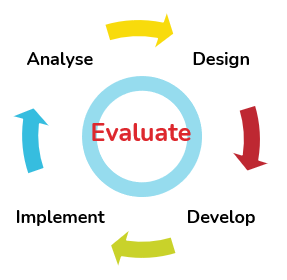Evaluation and assessment
Evaluation and assessment
 Evaluation is one of the most important parts of design - it’s good to be able to demonstrate what learners have achieved, both for the learner and you as a trainer (evidence of success!).
Evaluation is one of the most important parts of design - it’s good to be able to demonstrate what learners have achieved, both for the learner and you as a trainer (evidence of success!).
There are different levels of evaluation from ‘reaction’ eg how do learners feel after the course through to learning, behaviour and results.
Kirkpatrick, D. L. (1994). Evaluating training programs: the four levels.
San Francisco: Berrett-Koehler.
Reaction - how do learners feel after the training?
Learning - what have they learned from the training?
Behaviour - is this new learning being used in their workplace?
Results - what benefits are now being seen due to the new behaviours?
Reaction is one of the easiest to measure by post-training surveys (or ‘happy sheets’) which measure how a learner feels about the training, not necessarily what they have learned.
Behaviour and results are longer term so harder to measure but it’s possible with follow up activities, especially if you are running training for people within your own organisation.
The key point is that you should try to “design in” opportunities for assessment that enable you to evaluate and measure learning within a training session. You can also plan activities for after the training session if appropriate (for example a follow-up survey or drop-in session).
Summative vs Formative assessment
It’s useful to know the different between summative and formative assessment:
Summative assessment takes place at the end of a training course and usually results in a grading of some kind (Pass/Fail, % Score).
Formative assessment takes place during the training itself and provides an opportunity for observation and improvement. It can include scores and grading, but these are not linked to any kind of final result or certification.

Image credit: Iowa State University Centre for Excellence in Teaching and Learning
In the next section you’ll think about selecting the learning activities for your training - remember to think about how you can build in assessment and evaluation!